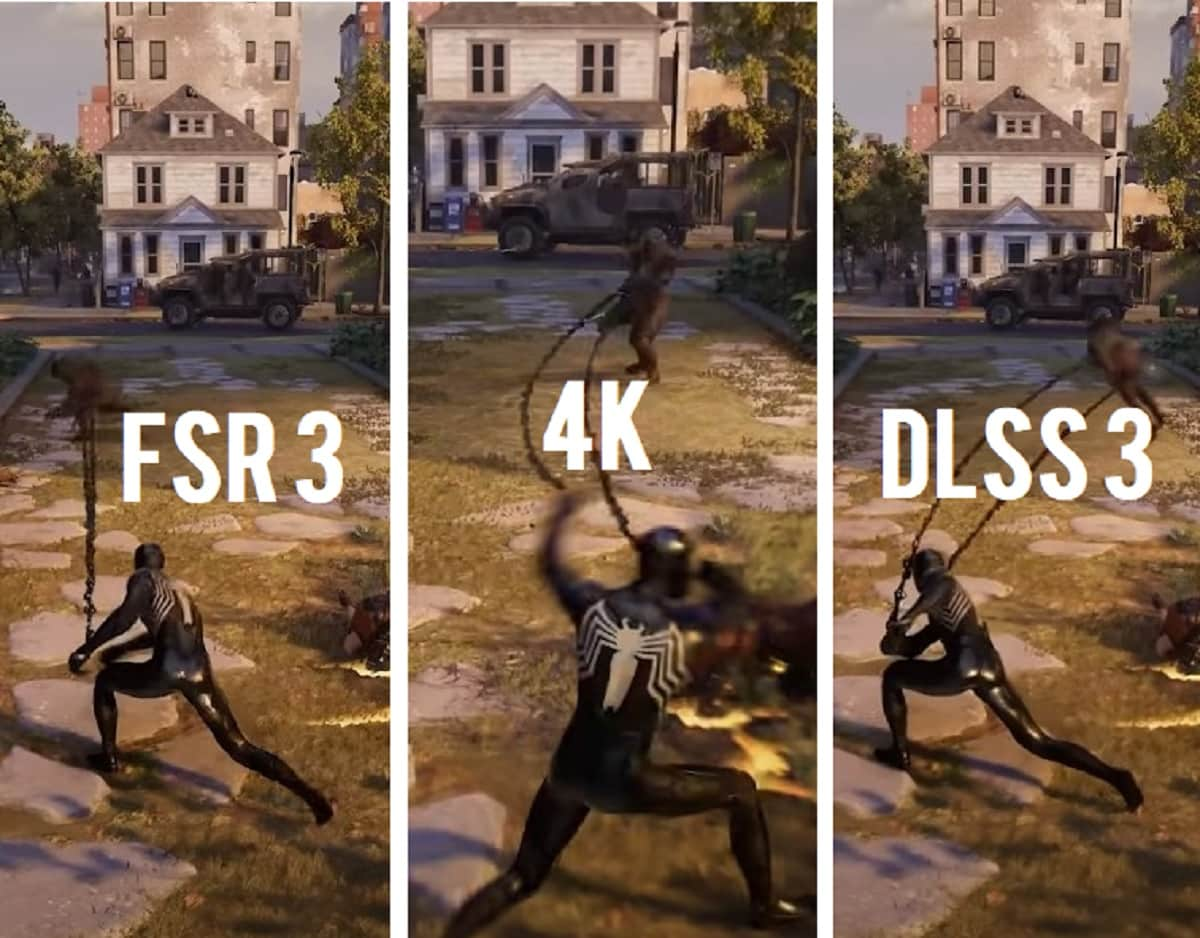In the ever-evolving world of gaming, advancements in graphics technology are always a hot topic. Two technologies that have recently garnered significant attention are AMD’s FidelityFX Super Resolution 3 (FSR 3) and NVIDIA’s Deep Learning Super Sampling 3 (DLSS 3). These technologies promise to enhance the gaming experience by improving performance and image quality. But how do they stack up against each other, and are they worth using? In this in-depth article, we’ll explore and compare FSR 3 and DLSS 3, taking a closer look at their features, performance, and real-world impact.
The Setup: FSR 3 vs. DLSS 3 Face-Off
To properly assess the capabilities of FSR 3 and DLSS 3, we need a controlled environment for testing. Our setup involves two high-end gaming systems, each running a different GPU – one equipped with an AMD Radeon 7900 XTX and the other with an NVIDIA RTX 4080. Both GPUs support their respective frame generation technologies, FSR 3 and DLSS 3. We’ll conduct side-by-side testing of these technologies in two games: “Immortals of AVM” and “Forspoken.”
Testing Equipment
Before diving into the details, let’s take a quick look at the hardware used for this comparison:
System 1 (AMD-based):
- GPU: AMD Radeon 7900 XTX
- Monitor: 120Hz variable refresh rate display
- Games: “Immortals of AVM,” “Forspoken”
System 2 (NVIDIA-based):
- GPU: NVIDIA RTX 4080
- Monitor: 120Hz G-Sync compatible display
- Games: “Immortals of AVM,” “Forspoken”
Our goal is to provide a comprehensive assessment of both frame generation technologies in various gaming scenarios and to answer the crucial question: Is it better to activate frame generation or keep it off?
Understanding FSR 3 and DLSS 3
Before we delve into the comparison, let’s briefly recap what FSR 3 and DLSS 3 are and how they work.
FidelityFX Super Resolution 3 (FSR 3)
FSR 3 is AMD’s take on frame generation technology, designed to enhance gaming performance and image quality. It employs upscaling techniques to increase the resolution of a game, making it visually appealing while keeping frame rates high. Notably, FSR 3 comes with a “frame generation” feature, which we’ll discuss in more detail shortly.
Deep Learning Super Sampling 3 (DLSS 3)
DLSS 3 is NVIDIA’s equivalent technology, leveraging deep learning and artificial intelligence to upscale lower-resolution images in real-time. Like FSR 3, DLSS 3 aims to deliver smoother gameplay without compromising image quality. It, too, has a frame generation component.
Frame Generation: FSR 3 vs. DLSS 3
One of the key differentiators between FSR 3 and DLSS 3 is their approach to frame generation. Both technologies aim to improve the overall gaming experience, but they do so in slightly different ways.
FSR 3 Frame Generation
FSR 3 introduces the concept of frame generation, which requires specific settings for optimal performance. Notably, it’s recommended to enable V-Sync and aim for a frame rate that closely matches your monitor’s maximum refresh rate. However, FSR 3 does not fully support variable refresh rate technologies like FreeSync and G-Sync, as it tends to lock the frame rate at the monitor’s maximum refresh rate.
DLSS 3 Frame Generation
DLSS 3, on the other hand, doesn’t always require V-Sync to be enabled through the game settings. It offers more flexibility, allowing users to force V-Sync through the driver panel for G-Sync compatible displays when necessary. DLSS 3 also handles variable refresh rate technologies better, ensuring a smoother gaming experience.
Immortals of AVM: FSR 3 vs. DLSS 3 Face-Off
FSR 3 Performance
Our initial testing in “Immortals of AVM” on the AMD Radeon 7900 XTX revealed some interesting findings. With FSR 3 frame generation enabled, the frame rate reached around 120 frames per second, effectively locking to the monitor’s maximum refresh rate. This resulted in visually smoother gameplay, even when the frame rate dipped slightly below 120 FPS. However, it’s worth noting that variable refresh rate technologies like FreeSync did not work correctly with FSR 3, leading to some inconsistencies.
DLSS 3 Performance
Switching to the NVIDIA RTX 4080 with DLSS 3 frame generation, we encountered a similarly smooth gaming experience. DLSS 3 managed to maintain a high frame rate, albeit with a more flexible approach to V-Sync. Unlike FSR 3, DLSS 3 offered better support for variable refresh rate technologies like G-Sync, ensuring tear-free gaming.
Menu Garbling: FSR 3 vs. DLSS 3
One intriguing observation was how the two frame generation technologies handled in-game menus, particularly in “Immortals of AVM.” DLSS 3 exhibited occasional garbling in the menus during transitions. In contrast, FSR 3 seemed to provide more stable menus without such artifacts.
Forspoken: FSR 3 vs. DLSS 3 Face-Off
FSR 3 Performance
Transitioning to “Forspoken,” we encountered different performance characteristics. With FSR 3 frame generation enabled on the Radeon 7900 XTX, we noticed juttery camera motion, especially when panning in certain directions. The base frame rate hovered around 50 to 60 FPS, dipping lower at times. However, enabling frame generation did push the frame rate closer to 100 FPS, albeit with occasional dips.
DLSS 3 Performance
Switching to the NVIDIA RTX 4080, we found similar issues with juttery camera motion in “Forspoken” when DLSS 3 frame generation was active. The base frame rate here was higher, which may have contributed to the perception of smoother motion in some directions. However, the camera panning still felt less juttery with frame generation off.

Conclusion: FSR 3 and DLSS 3
After extensive testing in two different games, it’s evident that the performance and user experience of FSR 3 and DLSS 3 can vary significantly depending on the game and hardware used. Here’s a summary of our findings:
Immortals of AVM:
| Technology | Frame Rate | Frame Generation | V-Sync Support | Overall Experience |
|---|---|---|---|---|
| FSR 3 | 120 FPS | On | Limited | Visually smoother |
| DLSS 3 | 120 FPS | Flexible | Better | Equally smooth |
Forspoken:
| Technology | Frame Rate | Frame Generation | V-Sync Support | Overall Experience |
|---|---|---|---|---|
| FSR 3 | 50-60 FPS | On | Limited | Juttery motion |
| DLSS 3 | 70-80 FPS | Flexible | Better | Juttery motion |
In conclusion, both FSR 3 and DLSS 3 offer significant improvements in gaming performance and image quality when used appropriately. However, their performance can vary depending on the game and hardware configuration. Users should carefully consider their gaming setup and preferences when deciding whether to enable frame generation with these technologies.
Ultimately, the choice between FSR 3 and DLSS 3 may come down to personal preference and the specific games you play. It’s recommended to test both technologies in your favorite games to determine which one provides the best experience for your setup. Additionally, keep an eye on driver updates and game patches, as improvements and optimizations are likely to continue rolling out for both FSR 3 and DLSS 3.
As technology continues to advance, the gaming experience will only get better, and frame generation technologies like FSR 3 and DLSS 3 are a testament to that progress. Happy gaming!







